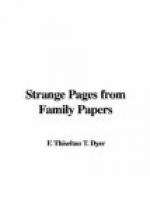Another equally strange incident connected with this mysterious crime happened to a Mrs. Brown, “perhaps from her holding some situation in the family of his uncle, Sir Robert.” On this fatal night, writes Sir Bernard Burke, she dreamt that one Mrs. Shearman—the housekeeper—came to her and asked for a sheet.
She demanded, “for what purpose,” to which Mrs. Shearman replied, “Poor Master Robert is killed, and it is to wind him in.”
Curious to say, in the morning Mrs. Shearman came at an early hour into her room, and asked for a sheet. For what purpose? inquired Mrs Brown.
“Poor Mr. Robert is murdered,” was the reply; “he lies dead in the Strand watch-house, and it is to wind his body in.”
In the year 1848, the Warwick magistrates investigated a most extraordinary and preposterous charge of murder against Lord Leigh, his deceased mother, and persons employed by them, in the course of which inquiry one of the accusers professed to have been in possession of a secret connected with the matter for a number of years. The accusation seems to have originated from the attempt of certain parties to seize Stoneleigh Abbey on pretence that it rightfully belonged to them, and not to Lord Leigh. In November, 1844, a mob took possession of the place for one George Leigh; several of the ringleaders were tried for the offence, and not fewer than twenty-eight were convicted. The account of this curious conspiracy, as given in the “Annual Register,” goes on to say that Richard Barnett made the charge of murder: in 1814 he was employed under Lady Julia Leigh and her son at the Abbey, where a number of workmen were engaged in making alterations; four of these men were murdered by large stones having been allowed to fall on them, and their bodies were placed within an abutment of a bridge, and then inclosed with masonry. Another man was shot by Hay, a keeper. In cross-examination, the witness said he “had kept silence on these atrocities for thirty years, because he feared Lord Leigh, and because he did not expect to obtain anything by speaking. He first divulged the secret to those who were trying to seize the estate; as this information he thought would help them to get it, for the murders were committed to keep out the proper owners.”
In the course of the inquiry, John Wilcox was required to repeat evidence which he had given before a Master of Chancery; but, instead of doing so, the man confessed that he was not sober when he made the declaration. He further declared how some servants of the Leigh family had burned pictures, and had been paid to keep “the secrets of the house.” The whole story, however, was a deliberate and wilful fabrication, the facts were contradicted and circumstantially refuted, and of course so worthless a charge was dismissed by the Bench.
FOOTNOTES:
[31] See “Annual Register” (1832), 152-5.




